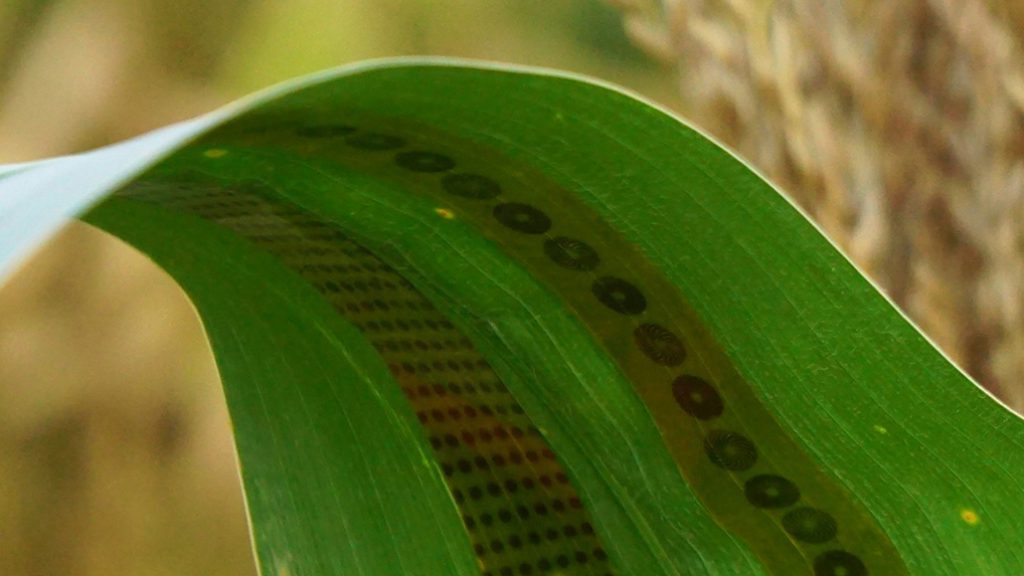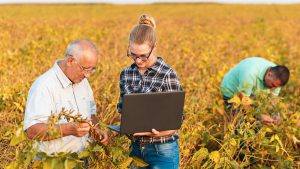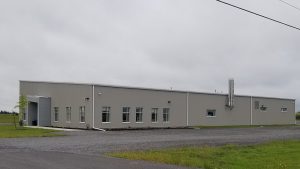Plant tattoos
IOWA RESEARCH TARGETS LOW-COST SENSORS

RESEARCHERS AT IOWA State University (ISU) are developing low-cost sensors, called “tattoos,” which can be attached to plants to measure key agronomic conditions such as moisture and nitrogen levels.
The technology can measure how corn plants move water from their roots to their lower leaves and then to their upper leaves.
“Once we can measure something, we can begin to understand it. With a tool like this, we can begin to breed plants that are more efficient in using water,” says Dr. Patrick Schnable, an ISU plant scientist who holds the Iowa Corn Endowed Chair in Genetics.
Schnable compares the plant tattoo sensors’ size to a band-aid and foresees the day when small terrestrial ground robots could be used to apply tattoos that would measure a wide variety of factors affecting crop production — not just moisture and nitrogen but also potassium, phosphorus, and possibly micronutrients.
The water-measuring tattoo uses graphene made from honeycombed sheets of carbon just one atom thick. Discovered in 2004, graphene is strong, stable, thin, almost completely transparent, extremely light, and an outstanding conductor of heat and electricity.
Using a molding process or 3-D printing, engineers can fabricate graphene patterns on tape, producing patterns as small as five millionths of a metre — small enough to increase the sensors’ sensitivity.
In laboratory and greenhouse studies, sensors made with graphene oxide were robust enough to hold up to environmental conditions and accurately measure water vapour changes to quantified moisture transpiration from plant leaves.
FIELD TESTING
A three-year, $472,363 grant from the U.S. Department of Agriculture’s (USDA) Agriculture and Food Research Initiative will support more field testing of water transport in corn plants.
The tattoos are proving easy to apply, and sampling means that only a few plants need to be tagged in a given acre.
Farmers should not expect to see this technology commercially available for several years, Schnable says, but the Iowa State University Research Foundation has applied for a patent on the sensor technology, and EnGeniousAg, an Iowa-based firm, has been granted an option to commercialize the technology.
EnGeniousAg has also received a $100,000 grant from USDA’s National Institute of Food and Agriculture to support efforts to develop soil and water sensors that can instantaneously or continuously measure available soil nitrate concentrations and nitrate loss to tile drainage water.
“We’re trying to make sensors that are cheaper and still high performing,” says Xinran Wang, EnGeniousAg operations manager.
“Farmer consulting service providers will be able to use measurements from EnGeniousAg’s new soil nitrate sensors to improve fertilizer recommendations. Similarly, when used to measure nitrate in soil and drainage waters, these sensors can measure outcomes and help farmers identify fields that would benefit from more intensive nitrogen-management practices.”
NITROGEN MANAGEMENT
Wang says successful nitrogen management can optimize crop yields, increase farmer profitability, and improve sustainability while minimizing nitrogen losses to the environment.
“After seed, nitrogen fertilizer is the second most costly farming input, yet it’s used with only 60% efficiency,” Wang says.
“Surveys show farmers want to better manage N to maintain profits and reduce environmental effects. But farmers lack the data they need to make decisions. EnGeniousAg is dedicated to providing farmers with the data they need to better manage N fertilization.”
Wang says the ability to take real-time measurements will be a game-changer relative to current N management practices.
“Our soil and water sensors will take the guesswork out of making nitrogen fertilizer application decisions. Decisions will no longer need to be based on generalized guidance for whole states and regions, or a few soil samples that require up to a week of laboratory processing before data are available to decision-makers. In contrast, EnGeniousAg’s sensors provide near-instantaneous results at high spatial resolution within farmer fields, thereby supporting precision agriculture,” he says.
The company is also developing sensors to measure nitrate concentrations inside of plants.
EnGeniousAg is a member of the ISU Startup Factory’s fifth cohort, a 52-week intensive program at the ISU Research Park that provides an avenue for students, faculty, staff, and community members to create technology-based, platform businesses. Entrepreneurs in the program receive formal training, resources, and access to a network of business mentors, advisors, counselors, and investors in two 26-week blocks: the first is a formal curriculum centered on business validation, while the second block is more customized to their individual business needs. •


























